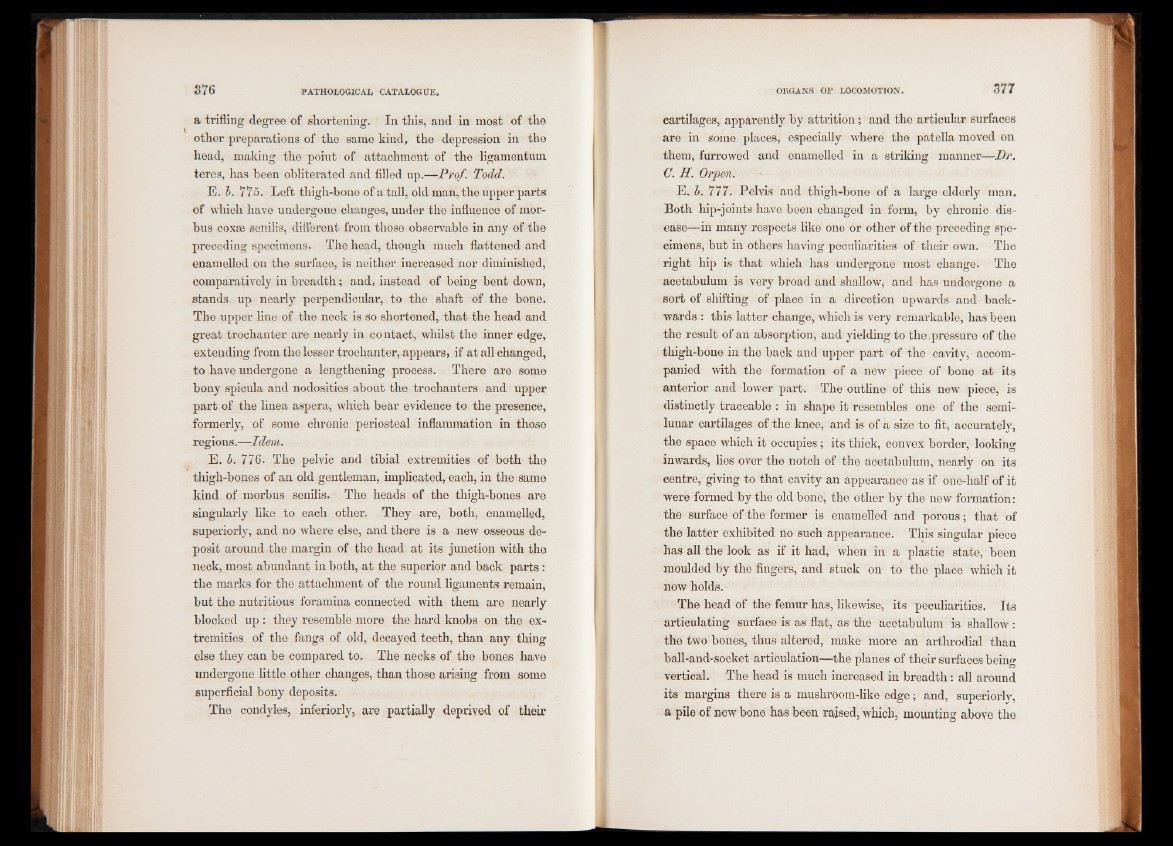
a trifling degree of shortening. In this, and in most of the
other preparations of the same kind, the depression in the
head, making the poiut of attachment of the ligamentum
teres, has been obliterated and filled up.—Prof. Todd.
E. b. 775. Left thigh-bone of a tall, old man, the upper parts
of which have undergone changes, under the influence of morbus
coxae senilis, different from those observable in any of the
preceding specimens. The head, though much flattened and
enamelled on the surface, is neither increased nor diminished,
comparatively in breadth; and, instead of being bent down,
stands up nearly perpendicular, to the shaft of the bone.
The upper line of the neck is so shortened, that the head and
great trochanter are nearly in contact, whilst the inner edge,
extending from the lesser trochanter, appears, if at all changed,
to have undergone a lengthening process. There are some
bony spicula and nodosities about the trochanters and upper
part of the linea aspera, which bear evidence to the presence,
formerly, of some chronic periosteal inflammation in those
regions.—Idem.
E. 1. 776. The pelvic and tibial extremities of both the
thigh-bones of an old gentleman, implicated, each, in the same
kind of morbus senilis. The heads of the thigh-bones are
singularly like to each other. They are, both, enamelled,
superiorly, and no where else, and there is a new osseous deposit
around the margin of the head at its junction with the
neck, most abundant in both, at the superior and back parts:
the marks for the attachment of the round ligaments remain,
but the nutritious foramina connected with them are nearly
blocked up : they resemble more the hard knobs on the extremities
of the fangs of old, decayed teeth, than any thing
else they can be compared to. The necks of the bones have
undergone little other changes, than those arising from some
superficial bony deposits.
The condyles, inferiorly, are partially deprived of their
cartilages, apparently by attrition; and the articular surfaces
are in some places, especially where the patella moved on
them, furrowed and enamelled in a striking manner—Dr.
C. H. Orpen.
E, b. 777. Pelvis and thigh-bone of a large elderly man.
Both hip-joints have been changed in form, by chronic disease—
in many respects like one or other of the preceding specimens,
but in others having peculiarities of their own. The
right hip is that which has undergone most change. The
acetabulum is very broad and shallow, and has undergone a
sort of shifting of place in a direction upwards and backwards
: this latter change, which is very remarkable, has been
the result of an absorption, and yielding to the pressure of the
thigh-bone in the back and upper part of the cavity, accompanied
with the formation of a new piece of bone at its
anterior and lower part. The outline of this new piece, is
distinctly traceable : in shape it resembles one of the semilunar
cartilages of the knee, and is of a size to fit, accurately,
the space which it occupies; its thick, convex border, looking
inwards, lies over the notch of the acetabulum, nearly on its
centre, giving to that cavity an appearance as if one-half of it
were formed by the old bone, the other by the new formation:
the surface of the former is enamelled and porous; that of
the latter exhibited no such appearance. This singular piece
has all the look as if it had, when in a plastic state, been
moulded by the fingers, and stuck on to the place which it
now holds.
The head of the femur has, likewise, its peculiarities. Its
articulating surface is as flat, as the acetabulum is shallow :
the two bones, thus altered, make more an arthrodial than
ball-and-socket articulation—the planes of their surfaces beintr
vertical. The head is much increased in breadth: all around
its margins there is a mushroom-like edge; and, superiorly,
a pile of new bone has been raised, which, mounting above the